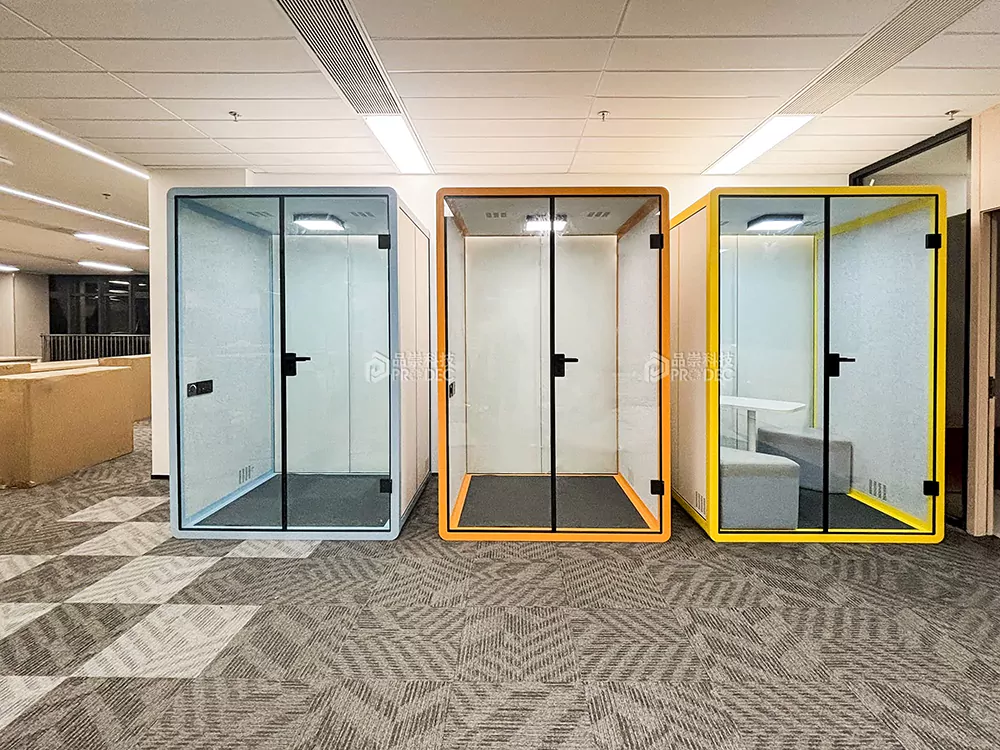Silent Room Booth: Solution for Focus and Privacy
What Is a Silent Room Booth and Why It’s Gaining Popularity
A silent room booth is a compact, sound-insulated enclosure designed to create a distraction-free environment for focused work, private conversations, or relaxation. Originally inspired by the need for acoustic privacy in open-plan offices, these pods have evolved into multifunctional spaces suitable for a wide range of environments—from corporate lobbies and coworking spaces to universities, hospitals, and even homes.
What sets a silent room booth apart is its advanced soundproofing technology. These units are constructed with high-density acoustic panels, double-glazed glass, and sealed door systems that effectively block external noise. This makes them ideal for phone calls, video conferencing, studying, or simply escaping the sensory overload of busy environments. As remote and hybrid work models continue to grow, the demand for personal, quiet zones has surged—making the silent room booth not just a luxury, but a necessity.
Manufacturers now offer modular designs that can be easily installed without major renovations. Whether you’re looking for a single-person pod or a larger 4-person meeting booth, the flexibility in size and function ensures there’s a solution for every space and budget.
Key Features That Define a High-Performance Silent Room Booth
To truly deliver on the promise of silence and comfort, a premium silent room booth incorporates several critical engineering and design elements. First and foremost is acoustic insulation. Top-tier models use multi-layered walls filled with sound-absorbing materials like mineral wool or foam, achieving noise reduction ratings (NRR) of up to 30 dB. This means ambient office chatter, hallway foot traffic, or city noise are rendered nearly inaudible inside the pod.
Another essential feature is ventilation. A sealed environment can quickly become stuffy, so integrated HVAC systems with quiet fans ensure fresh air circulation without compromising the sound barrier. Many modern booths also include intelligent lighting that adjusts based on time of day or user preference, enhancing focus and reducing eye strain.
From a technological standpoint, connectivity is key. Most silent room booths come equipped with built-in power outlets, USB charging ports, and HDMI or Ethernet connections for seamless integration with laptops and communication platforms like Zoom or Microsoft Teams. Some even feature touch-panel controls for adjusting lights, temperature, or booking the booth via a mobile app.

Ergonomics also play a vital role. Adjustable seating, height-appropriate desks, and thoughtful interior layouts ensure users can work comfortably for extended periods. When all these features come together, the result is a self-contained micro-environment optimized for productivity and mental clarity.
Where to Use a Silent Room Booth: From Offices to Homes
The versatility of the silent room booth makes it suitable for a wide array of settings. In modern offices, especially those embracing open layouts, these pods serve as private sanctuaries for confidential calls, deep work sessions, or impromptu team huddles. HR departments often use them for discreet employee interviews, while sales teams rely on them for client-facing virtual meetings.
In educational institutions, silent room booths are transforming libraries and study areas. Students can use them for online exams, group video projects, or uninterrupted study time—free from the distractions of crowded common areas. Universities are increasingly installing them near dormitories and academic buildings to support student well-being and academic performance.
Healthcare facilities are another growing market. Hospitals and clinics use these booths for telehealth consultations, patient counseling, or staff break rooms where employees can decompress in peace. The controlled acoustic environment ensures confidentiality and reduces stress in high-pressure settings.
Even private residences are adopting this trend. Homeowners with limited square footage or shared living spaces find silent room booths invaluable for creating a dedicated workspace, music practice area, or meditation zone. With prefab and modular options available, installation is straightforward and non-invasive, making it an attractive upgrade for smart homes.
Commercial Applications: Boosting Productivity and Employee Satisfaction
For businesses, investing in silent room booths isn’t just about aesthetics—it’s a strategic move to enhance workplace efficiency and employee satisfaction. Studies show that noise distraction costs companies billions in lost productivity annually. By providing employees with access to quiet, private spaces, organizations can significantly reduce cognitive fatigue and improve concentration.
Moreover, offering such amenities signals a commitment to employee well-being, which can boost morale and retention. Companies that integrate silent room booths into their office design often report higher engagement scores and more effective collaboration during hybrid meetings. These pods also support inclusivity by accommodating neurodivergent individuals who may be sensitive to sensory stimuli in open environments.
How to Choose the Right Silent Room Booth for Your Needs
Selecting the perfect silent room booth requires careful consideration of several factors: space availability, intended use, user capacity, and budget. Start by assessing your physical environment. Measure the area where the booth will be placed, keeping in mind clearance for doors to open and airflow around the unit.
Next, determine the primary function. If you need it mainly for solo tasks like writing or coding, a single-person pod with a desk and ergonomic chair will suffice. For collaborative work or small team meetings, opt for a larger 2–4 person model with a central table and enhanced audio-visual setup.
Material quality and build durability are crucial, especially in high-traffic areas. Look for frames made from powder-coated steel or aluminum, and interiors finished with anti-microbial, easy-to-clean fabrics. Check certifications for fire safety, electrical compliance, and acoustic performance to ensure reliability.
Don’t overlook mobility and scalability. Some models are mounted on casters for easy repositioning, while others are stackable or modular, allowing you to expand your setup as needs evolve. Finally, consider after-sales support—warranty length, installation assistance, and customer service responsiveness can make a big difference in long-term satisfaction.
Installation and Maintenance Tips for Long-Term Use
One of the biggest advantages of most silent room booth systems is their plug-and-play nature. Many units arrive pre-assembled or require minimal on-site assembly, often taking less than a few hours to set up. They typically only need a standard power outlet and, if applicable, a network connection. No structural modifications are usually required, making them ideal for leased spaces or temporary setups.
However, proper placement is key. Avoid positioning the booth directly under HVAC vents or near high-noise sources like printers or elevators. Ensure there’s adequate space around the unit for ventilation and user access. If placing multiple pods, maintain a logical flow to prevent congestion.
Maintenance is generally low-effort. Regular cleaning of interior surfaces with mild disinfectants helps maintain hygiene, especially in shared environments. Check seals and gaskets periodically to ensure they remain intact and airtight. Ventilation filters should be inspected and replaced every 6–12 months, depending on usage.
For tech components, routine software updates (if the booth has smart features) and cable management checks will keep everything running smoothly. With proper care, a high-quality silent room booth can last over a decade, delivering consistent performance and ROI.
The Future of Personal Quiet Spaces: Trends and Innovations
The evolution of the silent room booth is far from over. As urbanization increases and workspaces become denser, the demand for personal acoustic sanctuaries will only grow. Emerging trends point toward smarter, more adaptive designs. For instance, AI-powered booths could automatically adjust lighting, temperature, and even background soundscapes based on user preferences or biometric feedback.
Integration with building management systems (BMS) is another frontier. Imagine a silent room booth that syncs with your calendar, reserving itself when a meeting is scheduled or dimming lights when idle. Sustainability is also driving innovation—manufacturers are exploring eco-friendly materials, energy-efficient components, and recyclable construction to reduce environmental impact.
We’re also seeing a fusion of wellness and workspace design. Future models may include features like chromatherapy lighting, air purification, or even built-in meditation guides. As the line between work, learning, and personal life continues to blur, the silent room booth stands at the intersection of technology, psychology, and design—offering a simple yet powerful tool for reclaiming focus and peace in an increasingly noisy world.
本文由人工智能技术生成,基于公开技术资料和厂商官方信息整合撰写,以确保信息的时效性与客观性。我们建议您将所有信息作为决策参考,并最终以各云厂商官方页面的最新公告为准。






